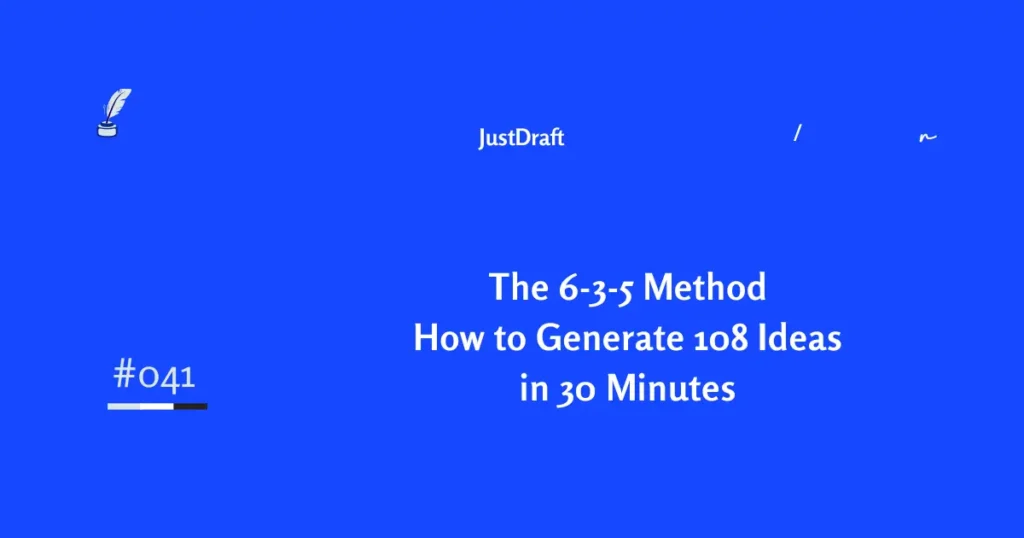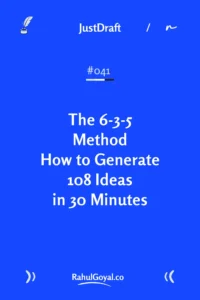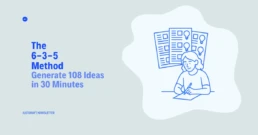The 6-3-5 Method: How to Generate 108 Ideas in 30 Minutes
You know that feeling when you’re stuck in a brainstorming session that’s going nowhere?
The same three people dominate the conversation. Half the team sits quietly, scrolling their phones. After an hour, you walk away with maybe two decent ideas—if you’re lucky.
Sound familiar? You’re not alone.
But, There’s a Better Way
One Topic: 6-3-5 Method
What if I told you there’s a method that can generate 108 ideas in just 30 minutes? And it works for everyone – even the quiet ones who rarely speak up.
Meet the 6-3-5 Method. It’s simple, powerful, and changes everything about how teams think together.
How 6-3-5 Method Works
The math is beautiful:
- 6 people
- 3 ideas each round
- 5 minutes per round
- 6 rounds total
Everyone starts with a blank sheet. They write three ideas related to your problem. After 5 minutes, they pass their sheet to the next person. The new person reads the existing ideas and adds three more—either building on what’s there or getting inspired to think differently.
After six rounds, you have 108 ideas. That’s 18 ideas per person, all sparked by collective creativity.
Why This Actually Works (When Brainstorming Fails)
Traditional brainstorming has 3 fatal flaws:
- Loud voices win → Introverts get ignored
- Groupthink → Ideas blend into “safe” mush
- No structure → Rambling eats time
The 6-3-5 fix:
- Silent creativity wins. No interruptions. No idea-stealing. No waiting for your turn to speak.
- Introverts shine. Some of our best thinkers process ideas internally. This method gives them space to contribute without the pressure of speaking up.
- Ideas build on ideas. Each round creates what I call “idea cross-pollination.” People see connections and possibilities they’d never think of alone.
- Speed matters. Five minutes isn’t enough time to overthink. You write what comes to mind, and often that’s where the magic happens.
Data point: Teams using 6-3-5 produce 5x more usable ideas (Berkeley study).
A Example
Last month, a group of startup team struggling with customer retention issue. Traditional brainstorming sessions kept circling back to the same discount strategies.
They tried 6-3-5 instead.
One quiet developer wrote: “What if we sent handwritten thank-you notes?” Another person built on it: “What if customers could write notes to future customers?” By round six, they had designed a complete peer-to-peer appreciation system.
Six weeks later, their retention rate jumped 23%.
The Simple Setup
Step 1: Define your challenge clearly. “How might we improve customer onboarding?” works better than “How can we be more innovative?”
Step 2: Get six people from different departments. Mix experience levels. Fresh eyes see different solutions.
Step 3: Create simple worksheets. Six columns (one per round), three rows (one per idea).
Step 4: Set a timer. Five minutes. No exceptions.
Step 5: Pass sheets clockwise after each round. No talking during rounds.
Step 6: After six rounds, collect everything. Sort ideas into themes. The real work begins here.

When It Works Best
Use 6-3-5 when you need:
- Fresh perspectives on old problems
- Ideas from everyone, not just the loud voices
- Quick results with limited time
- Solutions that build on each other
When to Skip It
Don’t use this method if:
- Your problem is too broad or undefined
- You need deep analysis, not creative options
- The group is too large (becomes messy) or too small (limits cross-pollination)
Making It Work Remote
Virtual teams can use this too. Tools like Miro or even Google Sheets work perfectly. The key is keeping the timer strict and the process silent.
The Real Magic
The 6-3-5 method isn’t just about generating ideas. It’s about changing how teams think together.
It says: “Every voice matters. Every perspective adds value. Great solutions come from collective creativity, not individual genius.”
Try this at your next team meeting. Pick a real challenge you’re facing. Follow the process exactly as outlined. Don’t modify it – at least not the first time.
You might be surprised what your team can create when everyone gets a chance to contribute.
After all, the best ideas often come from the quietest voices in the room.
Read last week’s JustDraft newsletter about Design Thinking Process 5 Stages.
Interested in travel, Read last week’s LensLetter about August Astrophotography Calendar.
Two Quotes to Inspire
Creativity thrives in silence, not noise.
Structure sets ideas free.
One Passage From My Bookshelf
You can’t be creative without action. If you just sit there waiting for inspiration to strike, you might be waiting forever. Creativity is doing, not just thinking. That’s why we tell teams: start by showing, not telling. Once ideas are out in the world—even messy ones—they can be improved.
📚 From Creative Confidence by Tom Kelley


